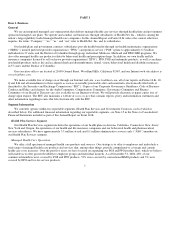Health Net 2004 Annual Report Download - page 13
Download and view the complete annual report
Please find page 13 of the 2004 Health Net annual report below. You can navigate through the pages in the report by either clicking on the pages listed below, or by using the keyword search tool below to find specific information within the annual report.
Ancillary and Other Provider Relationships
Our health plan subsidiaries arrange for ancillary and other provider services, such as ambulance, laboratory, radiology and
home health primarily through contracts with selected providers in their service areas. These contracts generally have multi-year
terms or annual terms with automatic renewals and provide for payments on a variety of bases, including capitation, per diem rates,
case rates and discounted fee-for-service schedules. In certain cases, these provider services are included in contracts our health plan
subsidiaries have with PPGs and hospitals.
Additional Information Concerning Our Business
Competition
We operate in a highly competitive environment in an industry currently subject to significant changes from business
consolidations, new strategic alliances, legislative reform and market pressures brought about by a better informed and better
organized customer base. Our HMOs face substantial competition from for-profit and nonprofit HMOs, PPOs, self-funded plans
(including self-insured employers and union trust funds), Blue Cross/Blue Shield plans, and traditional indemnity insurance carriers,
some of which have substantially larger enrollments and greater financial resources than we do. The development and growth of
companies offering Internet-based connections between health care professionals, employers and members, along with a variety of
services, could also create additional competitors. We believe that the principal competitive features affecting our ability to retain and
increase membership include the range and prices of benefit plans offered, size and quality of provider network, quality of service,
responsiveness to user demands, financial stability, comprehensiveness of coverage, diversity of product offerings, and market
presence and reputation. The relative importance of each of these factors and the identity of our key competitors varies by market.
Over the past several years, a health plan’s ability to interact with employers, members and other third parties (including health care
professionals) via the Internet has become a more important competitive factor. To that end, we have made technology investments to
enhance our electronic interactions with third parties. We believe that we compete effectively against other health care industry
participants.
Our key competitors in California are Kaiser Permanente, Blue Cross of California, PacifiCare of California and Blue Shield of
California. Kaiser is the largest HMO in California based on number of enrollees and Blue Cross of California is the largest PPO
provider in California based on number of enrollees . All together, these four plans and Health Net account for a majority of the
insured market in California. There are also a number of small, regional-based health plans that compete with Health Net primarily in
the small business group market segment. The combined commercial HMO membership for Aetna, Inc., CIGNA Corp. and the
regional plans constitutes approximately 7% of the insured market in the state.
Our largest competitor in Arizona is Blue Cross/Blue Shield. Our Arizona HMO also competes with UnitedHealth Group Inc.,
CIGNA, PacifiCare Health Systems, Inc., Aetna and Humana Inc. Our Oregon health plan competes primarily against Kaiser,
PacifiCare of Oregon, Providence, Regence Blue Cross Blue Shield and Lifewise.
Our Connecticut health plan competes for business with WellPoint, Inc., ConnectiCare, Inc. and CIGNA. Our main competitors
in New York are UnitedHealthcare/Oxford Health Plans, WellChoice, Inc. and Aetna. Our main competitors in New Jersey are
UnitedHealthcare/Oxford Health Plans, Horizon Blue Cross and Health Insurance Plan of New York.
Marketing and Sales
We market our products and services to individual members through independent brokers, agents and consultants and through
the Internet. We market our products and services for our group health business utilizing a three-step process. We first market to
potential employer groups and group insurance brokers and consultants.
10
























